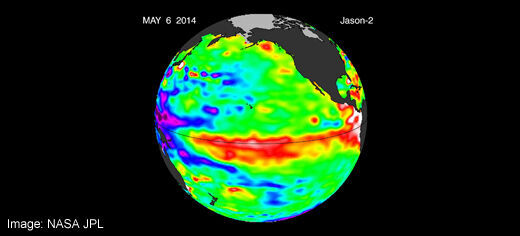
Scientists have announced the findings of the first study on the connection between the El Niño and global crop yield fluctuations, providing a new tool for adapting food security to climate change.
Study co-author Professor Andy Challinor, from the School of Earth & Environment at the University of Leeds, said: “The IPCC Fifth Assessment Report highlighted that we expect a decrease in the year-to-year stability of our food supply and that we need to act now to safeguard food production in the future.
“This new work tells us that we can predict when the bad years will be, ahead of the harvest.”
Previously, the reliability of seasonal crop yield forecasts had been insufficient for mid- and high-latitude regions due to weaker influences of the tropical oceans and because some crops in these areas are more greatly influenced by soil water content than temperature.
As the prediction of El Niño and the lesser known La Niña – a warming and cooling, respectively, of the sea surface temperatures in the tropical Pacific – are highly accurate, they could be used to improve the harvest forecast of crops in those areas.
In the new study, which is published today in the journal Nature Communications, an international team of researchers found that in both El Niño and La Niña years, the global mean yield of corn, rice and wheat is much lower than normal. The response of the soybean yield in La Niña years is unclear, but the study found an increase in El Niño years.
The research also shows that the region in which the yield of crops is negatively affected by La Niña is smaller than the region affected by El Niño; the negative impacts of La Niña affect 9-13% of harvested areas worldwide, compared to 22-24% for El Niño.
However, unlike El Niño years, the area that is affected in a positive way in La Niña years is much smaller than the region that is affected negatively – only 2-4% of harvested areas worldwide.
Study lead author Dr Toshichika Iizumi, from the National Institute for Agro-Environmental Sciences in Japan, said: “The El Niño remains a concern for regions where crop production is negatively affected, but we need to pay more attention to La Niña from a food trade point of view.”
Professor Challinor concluded: “The study shows that measures need to be taken to safeguard food supply in bad years and also to make the most of good years. Actions range from targeted crop management through to crop insurance and management of food storage.”
Further information
Professor Andy Challinor is a lead author of the IPCC Fifth Assessment report and will be presenting at the Transformational Climate Science 2014 conference in Exeter on 15-16 May 2014.
To arrange an interview with Professor Challinor, please contact the press office on 0113 343 4031 or email pressoffice@leeds.ac.uk
The research paper, ‘Impacts of El Niño Southern Oscillation on the global yields of major crops’, is published online today in Nature Communications.
Image
The El Niño is evident in satellite images that show the sea surface height. In this image, a region of warm water (shown in red) is caused by the El Niño and has created a higher sea level in the Pacific.
Image credit: NASA JPL (Jet Propulsion Laboratory)